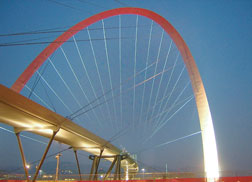 |
| Unswayed.Italian bridge built for Winter Olympic village will feature dampers to stop footstep-caused sway. |
Engineers are using lessons learned from London’s Millennium Bridge, notorious for wobbling on its opening day, to prevent an unwelcome repeat situation on a slender, curved new cable-stayed structure nearing completion in Turin, Italy. In the absence of design codes for pedestrian-induced sway, the new bridge’s designer asked engineers of the London structure to devise a damping system.
都灵的368米长,11-mil美元lion bridge links the city’s Winter Olympic village with the recently completed Lingotto commercial center. Its 156-m-long main span, which soars over railroad tracks, is supported by eight pairs of cable stays. These are anchored to a 69-m-tall parabolic arch, which spans 55 m across the deck. With a box section of three 3-m sides, the arch leans toward the railroad and is stabilized by eight pairs of back stays.
The bridge is one of the projects commissioned by Olympics organizer Agenzia Torino 2006. The design contract went to Paris-based architect Hugh Dutton Associates, following a competition in 2002. The firm also employs engineers, and “we felt…we could do both disciplines,” says principal Hugh Dutton. But to prevent swaying of the 660-tonne, 4-m-wide deck, Dutton turned to Arup Group, London.
 |
“We based [the Turin bridge work on] the research we carried out on the Millennium Bridge,” says Arup Director Pat Dallard. “Codes still haven’t caught up.” Dallard was on the design team responsible for the London River Thames crossing that was shut down after dramatic swaying alarmed users on its opening day in June 2000 (ENR 7/10/00 p. 14). It took some 100 tonnes of dampers and several million dollars of work to steady the bridge.
Arup discovered that the Millennium Bridge swaying was caused by lateral forces produced by pedestrians synchronizing their footsteps to initially small movements. Dallard calls this “negative damping,” which is likely for structures with natural frequencies of 1.2 cycles per second and under. Two 5-tonne tuned mass dampers at mid-span will provide the main damping of the Turin. And because the deck is curved, two viscous dampers at one end will also help.
Installing dampers is yet to be done, though the bridge was in partial use during the winter games. Local contractor ATI Serena Falcone started work in late 2004, but was delayed by foundation problems, says Dutton. The bridge is slated to open this May or June.
(Photos courtesy of Hugh Dutton Associates)
